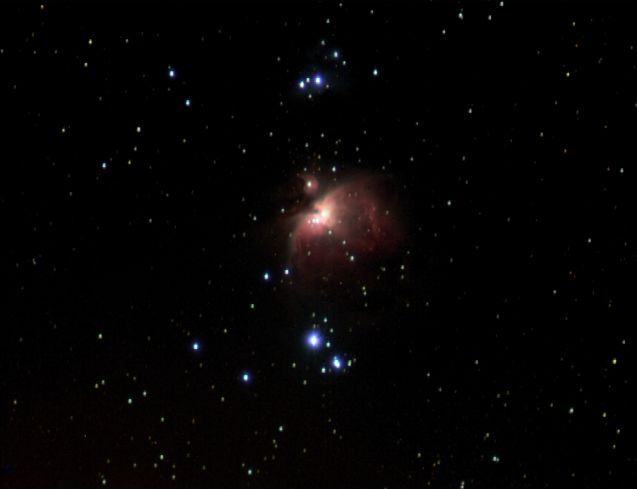M42 in natural colour; 17th January 2010
This is a wider-angled pictures of M42 taken using my 135-mm SLR lens at f/4 and broadband LRGB filters. This should produce a more realistic colour than in the picture produced from the three narrow-band filters.

|
This picture was made using the LRGB filters from Astronomik and so produces a realistic colour for the nebula. Although this should be similar to what you would see at the eyepiece if the eye were sensitive to colour at these low intensities, the exact colour does depend on the relative sensitivity of the filter-camera combination at each wavelength. I do not have a calibration for this combination, so the images were used as taken by the camera.
If you move your mouse over the picture, you will see the corresponding image made using the three narrow-band filters, Hα, OIII, and SII, for comparison. In addition, I have added, on the mouseover picture, an image of the full Moon taken with the same optics a few days earlier (the December Blue Moon) to give a better idea of just how large the Orion nebula is in the sky. (At the time the Moon was 360,000 Km away, and the Orion nebula was at least 1,000 light-years away.)
|
| Date and Time |
17th January 2010 21:30 to 22:01 UT |
Camera |
Starlight Xpress MX716 |
Telescope |
135-mm SLR lens at f/4 with Astronomik filters |
Capture |
Star_mx7 10 seconds at full resolution. |
Processing |
Star-MX7: automatic black adjustment, non-linear enhancement 25, automatic black adjustment again. This was applied to each frame individually.
Irfanview: batch conversion to png format.
Registax5: Stacked 20 frames (R, G), 10 frames (B), gamma 1.5, histogram 15-255
Photoshop: Combined four images to create LRGB picture.
|
Home Back to DSOs


